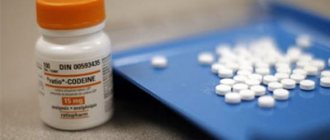Vitrum Prenatal Plus, film-coated tablets, 30 pcs.
Compound:
calcium carbonate, carrier microcrystalline cellulose, vitamin C (ascorbic acid), iron fumarate, vitamin E (dl-alpha tocopherol acetate), stabilizer stearic acid, magnesium oxide, stabilizer croscarmellose, Opadry II white tablet coating (stabilizer hydroxypropyl methylcellulose, titanium dye dioxide, carrier polydextrose, anti-caking agent talc, maltodextrin, medium chain triglycerides), stabilizer silicon dioxide, zinc oxide, nicotinamide, stabilizer magnesium salt of stearic acid, manganese sulfate, calcium-D-pantothenate, beta-carotene, vitamin A (retinol acetate), folic acid, vitamin D3 (cholecalciferol), vitamin B6 (pyridoxine hydrochloride), vitamin B 1 (thiamine nitrate), vitamin B2 (riboflavin), D-biotin, chromium chloride, copper oxide, potassium iodide, sodium selenate, vitamin B12 (cyanocobalamin ).
One tablet contains:
| Biologically active substance | 1 tablet contains, mg | % of recommended level* | ||
| Pregnant women (1st half) | Pregnant women (2nd half) | Nursing | ||
| Vitamin A, RE | 0,75 (0,67-1,13) | 83 (74 — 125) | 75 (67 — 113) | 58 (52 — 87) |
| Beta carotene | 1,5 (1,35- 2,25) | 30 (27 — 45) | 30 (27 — 45) 2 | 30 (27 — 45) 2 |
| Vitamin E, TE | 20,1 (18,1 — 30,2) | 134 (121 — 201) ** | 118 (106 — 177) ** | 106 (95,4 — 159)** |
| Vitamin D3, mcg | 10 (9,0-15,0) | 100 (90-150) | 80 (72 — 120) | 80 (72 — 120) |
| Vitamin C | 120 (108-180) | 133 (120 — 200)** | 120 (108-180)** | 100 (90-150) |
| Vitamin B1 | 3 (2,7-4,5) | 200 (180 — 300)** | 200 (180 — 300)** | 167 (150-251)** |
| Vitamin B2 | 3,4 (3,06-5,10) | 189 (170-284)** | 189 (170-284)** | 162 (146-243)** |
| Vitamin B6 | 3(2,7-4,5) | 150 (135-225)** | 150 (135-225)** | 120 (108-195)** |
| Folic acid, mcg | 400 (360-600) | 100 (90-150)** | 100 (90-150)** | 80 (72-100) |
| Vitamin B12, mcg | 4,5 (4,1-6,7) | 150 (135-225)** | 150 (135-225)** | 129 (116-193)** |
| Niacin | 20 (18-30) | 100 (90-150) | 100 (90-150) | 87 (78-131) |
| Vitamin B5 | 7 (6,3-10,5) | 140 (126-210)** | 140 (126-210)** | 100 (90-150) |
| Biotin, mcg | 30 (27 — 45) | 60 (54-90) 1 | 60 (54-90)1 | 60 (54-90) 1 |
| Calcium | 200 (180 — 250) | 20 (18-25) | 15 (14-19) | 14 (13-21) |
| Iron | 32 (28,8–40,0) | 178 (160 —223) ** | 97 (87-121) | 178 (160-223)** |
| Zinc | 18 (16,2-22,5) | 150 (135-188)** | 120 (108-150)** | 120 (108-150)** |
| Copper | 2 (1,8-2,5) | 200 (180-250)** | 182 (164 −228)** | 143 (129- 168)** |
| Manganese | 3,3 (2,97-4,12) | 165 (149-206)** | 150 (135-188)** | 118 (106-148)** |
| Chromium | 25 (22,5-40,0) | 50 (45-80) | 50 (45-80) 2 | 50 (45-80)2 |
| Iodine | 150 (135-240) | 100 (90-160) | 68 (61-109) | 52 (47-83) |
| Selenium | 25 (22,5-40,0) | 45 (41-72) | 38 (34-61) | 38 (34-61) |
* according to MP 2.3.1.2432-08 “Norms of physiological needs for energy and nutrients for various groups of the population of the Russian Federation”;
** Does not exceed the upper permissible level of consumption in accordance with the Unified Sanitary-Epidemiological and Hygienic Requirements for Goods Subject to Sanitary-Epidemiological Surveillance (Control) (Chapter II, Section 1, Appendix 5);
1-% of the recommended daily requirement according to TR CU 022/2011, Appendix 2;
2-% of the adequate level of daily consumption according to the “Unified Sanitary-Epidemiological and Hygienic Requirements for Goods Subject to Sanitary-Epidemiological Surveillance (Control)” (Chapter II, Section 1, Appendix 5).
Vitamin A
— Cell growth and differentiation factor. Promotes the development of fetal lung tissue, regulation of the function of surface-active proteins of the fetal alveoli. Participates in the formation of barrier (local) immunity and prevents the development of viral infections. Promotes the development of the placenta, growth, normal development and differentiation of embryonic tissues, incl. epithelial structures and bone tissue. Participates in the formation of visual pigments necessary for normal twilight and color vision; ensures the integrity of epithelial tissues.
Beta carotene
is a natural provitamin A, has antioxidant properties that block peroxide compounds that can cause precancerous changes in cells. Beta-carotene relieves many vision disorders, participates in the formation of bone tissue and teeth, maintains healthy skin, hair, mucous membranes, and increases the body's resistance to respiratory and other infections. In case of retinol (vitamin A) deficiency, beta-carotene can break down into two retinol molecules.
Vitamin E
- supports the normal course of the entire pregnancy. An antioxidant that protects other vitamins from destruction. Maintains the stability of red blood cells, prevents hemolysis; has a positive effect on the functions of the gonads, nervous and muscle tissue.
Vitamin D3
— ensures the exchange of calcium and phosphates, the growth of the fetal bone skeleton, promotes bone mineralization, the formation of the bone skeleton and teeth in children, and is necessary for the normal functioning of the parathyroid glands. Prevents the development of preeclampsia in pregnant women and premature birth.
Vitamin C
— provides the synthesis of collagen, carnitine, dopamine, tyrosine, norepinephrine, pituitary hormones, thyroid hormones and steroid hormones. Affects the formation of hemoglobin and the maturation of red blood cells. Vitamin C increases the body's resistance to infections and reduces inflammatory reactions.
Vitamin B1 (thiamine)
- participates in the absorption of simple sugars. Prevents excess weight gain in pregnant women. Participates in the functioning and formation of the fetal nervous system.
Vitamin B2 (riboflavin)
- participates in the metabolism of carbohydrates, fats and proteins in the mother and fetus. Prevents the development of mastitis during feeding. The most important catalyst for the processes of cellular respiration and visual perception of the fetus.
Niacin (vitamin B3, vitamin PP, nicotinamide)
— ensures the synthesis of the most important enzyme cofactors (NAD group): DNA repair, synthesis of steroid hormones, detoxification of xenobiotics, energy metabolism. Participates in the formation of blood vessels of the placenta.
Pantothenic Acid (Vitamin B5)
- participates in the metabolism of carbohydrates, fats and proteins. Promotes rapid healing of tissues after childbirth. Provides tissue reparative function.
Vitamin B6 (pyridoxine)
- participates in the metabolism of amino acids. Counteracts the appearance of pregnancy toxicosis and convulsions. Ensures normal absorption of magnesium. As a coenzyme, it takes part in protein metabolism and the synthesis of neurotransmitters. Necessary for folic acid (folate cycle). During pregnancy, it is necessary for women who have previously taken oral contraceptives, which deplete the body's reserves of pyridoxine.
Biotin (vitamin B7)
- participates in carbohydrate and fat metabolism. Forms normal fetal skin. Maintains normal blood sugar levels and prevents diabetes.
Folic acid (vitamin B9, Sun)
- participates in DNA synthesis and DNA methylation. Ensures the growth of all embryonic cells. In the early stages of pregnancy, it reduces the risk of developing neural tube defects in the fetus, as well as the risk of malformations of the maxillofacial area.
Vitamin B12 (cyanocobalamide)
- participates in catabolism (breakdown and resynthesis) of amino acids, fatty acids and nucleotides. Ensures the growth of all embryonic cells. It is an important factor in hematopoiesis and the development of epithelial cells; necessary for folic acid metabolism (folate cycle) and myelin synthesis. Increases the resistance of red blood cells to hemolysis. Increases the ability of tissues to regenerate.
Iron
- participates in erythropoiesis, as part of hemoglobin it ensures the transport of oxygen to tissues; prevents the development of anemia in pregnant women, especially in the second and third trimesters of pregnancy. Iron contributes to the normal development of the infant's cognitive functions.
Zinc
- participates in the normal formation of the fetal skeleton and tissue regeneration, participates in the formation of certain hormones, including insulin; reduces the likelihood of developing intrauterine anomalies. In combination with vitamin A, it promotes the formation of normal twilight and color vision.
Copper
- prevents anemia and oxygen starvation of organs and tissues, helps prevent osteoporosis. Helps strengthen the walls of blood vessels.
Manganese
- promotes bone mineralization. Has anti-inflammatory properties.
Chromium
— increases tissue sensitivity to insulin, reduces the risk of impaired glucose tolerance and gestational diabetes.
Iodine
- necessary for the formation of thyroid hormones and normal function of the thyroid gland: participates in lipid and protein metabolism. Reduces the risk of complications during pregnancy that occur due to iodine deficiency: intrauterine fetal death and spontaneous abortion. Prevents retardation in mental and physical development.
Selenium
— provides antioxidant protection of cell membranes, potentiates the effect of vitamin E. Necessary for the normal functioning of the immune system.
Calcium
- participates in the regulation of nerve conduction, muscle contractions and is a component of the blood coagulation system, increases bone density.
Vitrum Prenatal Plus tab. p/capt.ob. 1470 mg±5% №100
Name
Vitrum Prenatal Plus tab. p/capt.ob. 1470 mg±5% №100
Description
Capsule-shaped tablets, film-coated from light pink to dark pink. A specific odor is allowed.
Main active ingredient
Multivitamin+multimineral
Release form
Pills
special instructions
Do not exceed the recommended dose. It is not recommended to use Vitrum Prenatal together with medications containing vitamins A and D. This increases the risk of an overdose of these vitamins.
pharmachologic effect
They are determined by the properties of the vitamins and minerals that make up the drug. The drug provides replenishment of the deficiency of vitamins and minerals in a woman’s body during pregnancy and breastfeeding.
Indications for use
prevention of hypovitaminosis, lack of minerals during pregnancy and breastfeeding; prevention of iron deficiency anemia and calcium deficiency in pregnant women.
Directions for use and doses
Consult your physician before use. It is recommended that women during pregnancy and after childbirth take one tablet orally per day after breakfast with water. The course of taking the drug is recommended by a doctor.
Interaction with other drugs
The drug contains iron and calcium and therefore can delay the absorption in the intestine of antibiotics from the tetracycline group, as well as antimicrobial agents - fluoroquinolone derivatives. Vitamin C enhances the effect and side effects of antimicrobial agents from the sulfonamide group (including the appearance of crystals in the urine). Antacids containing aluminum, magnesium, calcium, and cholestyramine reduce iron absorption. With the simultaneous administration of diuretics from the thiazides group, the likelihood of hypercalcemia increases.
Contraindications
Hypersensitivity to any of the components of the drug. It is not recommended to use in case of hypervitaminosis A and D, excessive accumulation of iron in the body, increased calcium levels in the blood, increased excretion of calcium in the urine and urolithiasis.
Compound
text
Overdose
Symptoms of overdose: nausea, weakness, gastrointestinal disorders. In case of accidental overdose, consult a doctor. Liver: activated carbon orally, gastric lavage, symptomatic treatment.
Side effect
Allergic reactions to the components of the drug are possible. It is possible that urine may turn an intense yellow color, which is not dangerous, as it is due to the presence of riboflavin in the drug.
Storage conditions
In a dry place, at a temperature of 10-30 °C. Keep out of the reach of children.



